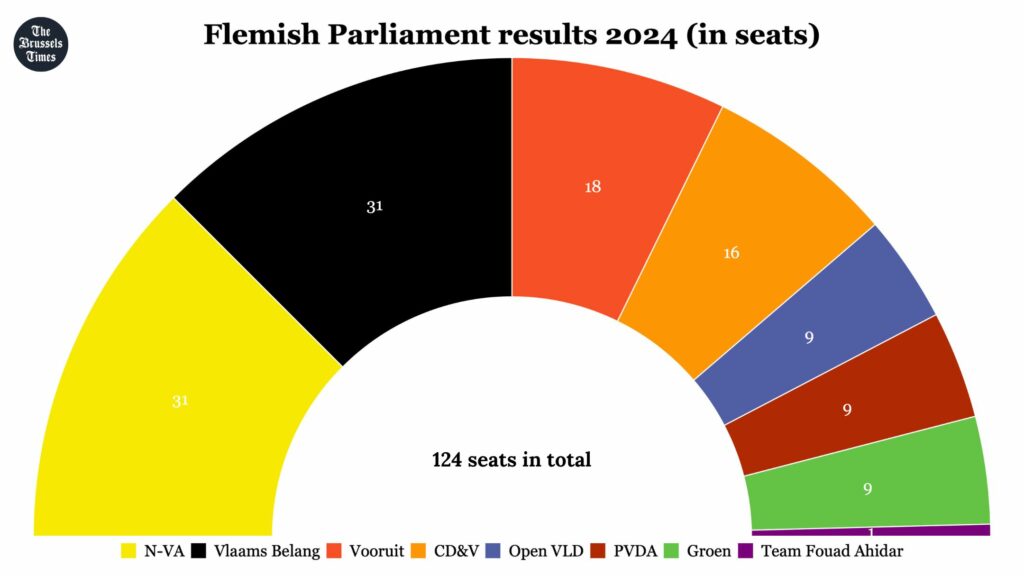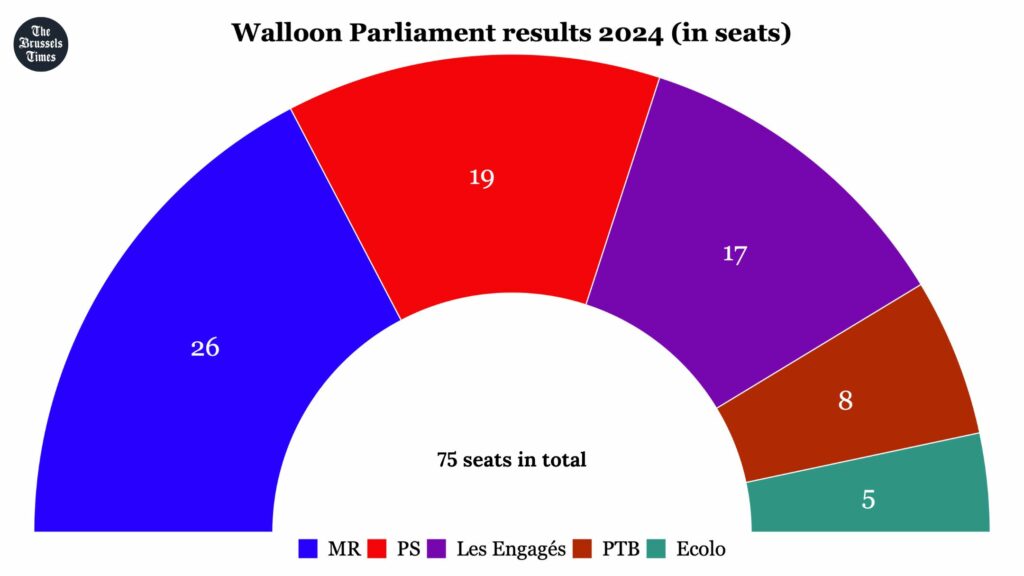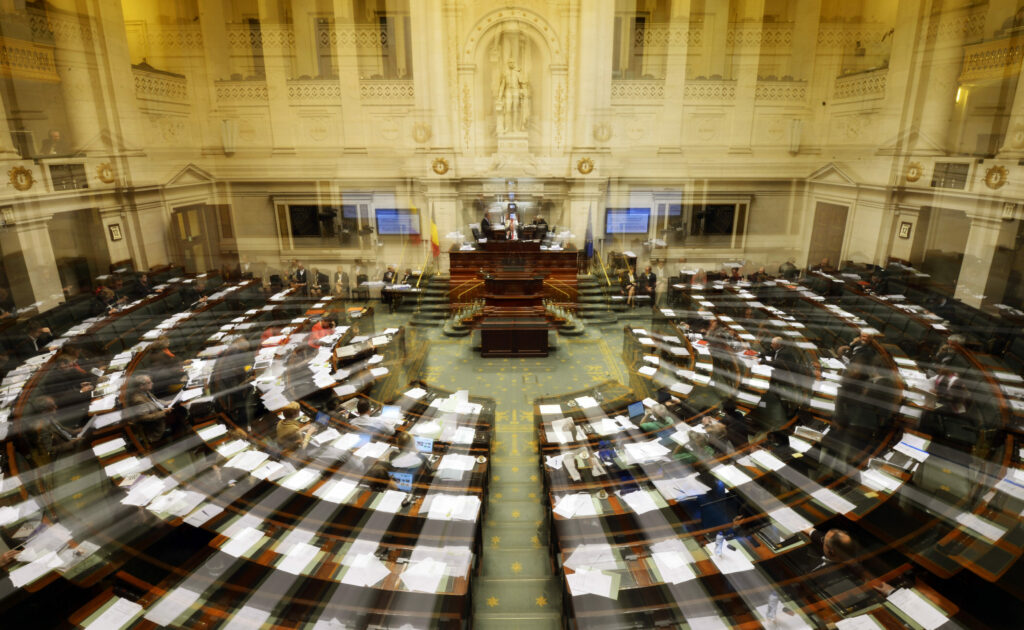Belgium's political landscape was severely shaken in Sunday's triple-election showdown, with some widely-held predictions failing to materialise whilst others were far surpassed. Now that all votes have been counted, the arduous task of forming a government lies ahead. But what partnerships could form Belgium's next governments?
On a federal level, coalition talks are notoriously complicated. It took almost 500 days to form the so-called 'Vivaldi' government after the 2019 elections. In 2010–2011, it took 541 days. To understand the mechanisms of forming a Federal Government, see here.
At the regional level, discussions are often long-winded and this time around are complicated by substantial shifts to the right. The Brussels Times outlines the possible scenarios for coalitions on all government levels.
The Federal Government
With a total of 150 seats in the Federal Parliament (Chamber), a coalition must have 76 seats to secure a majority.
The right-wing Flemish N-VA party was again the largest group, securing 24 seats at the federal level. In joint second with 20 seats each are far-right Vlaams Belang and French-speaking liberal Mouvement Réformateur (MR). The latter is the largest French-speaking party in the Chamber. The French-speaking Socialist Party (PS) was fourth at the federal level with 16 seats, one more than the Workers' Party (PTB-PVDA), which secured 15 seats.

Data: Home Affairs Ministry. Credit: The Brussels Times
The first coalition considered by political analysts would be a centre-right formation whose main partners would be the N-VA, French-speaking liberals MR, and Dutch-speaking liberals Open VLD. The majority would made up by incorporating the Christian-Democrats CD&V on the Flemish side and Les Engagés on the French-speaking side.
Together, this grouping would have a narrow majority of 76 out of 150 seats. These parties are aligned on socioeconomic issues, which should facilitate negotiations. However, after coming out as the biggest loser of the elections on the Flemish side, Open VLD has now ruled out participating in future governments. As such, this centre-right coalition would no longer have a majority.

Credit: Belga
An alternative would be to instead bring in Flemish-speaking socialists Vooruit, whose 13 seats would give this coalition a majority of 82 seats. However, Vooruit president Melissa Depraetere has indicated that she would require sufficient concessions from partners if Vooruit were to govern without its French-speaking sister party the PS.
"Vivaldi 2": Mathematically, keeping the same partners as made up the last Federal Government could still work, but only with the slimmest of majorities: 76 seats. Nicknamed the "Vivaldi" coalition, this comprises the liberals (Open VLD and MR), the socialists (Vooruit and PS), the Greens (Groen and Ecolo) and CD&V (without Les Engagés). However, PS on Monday said it would not enter any governments. This would render this coalition impossible.
But as before, this would not work without the participation of Open VLD. Moreover, it would include the biggest losers (Open VLD on the Dutch-speaking side and Ecolo on the French-speaking side) whilst excluding the N-VA. This already caused major tensions after the 2019 election.
A classic tripartite (involving three parties) with the socialists (PS and Vooruit), Liberals (Open VLD and MR) and the Christian-Democrats (Les Engagés and CD&V) would make 81 seats. But as before, this would not work without Open VLD, nor without PS, were they to stick to their decision.
Alternatively, a tripartite coalition with the addition of N-VA would have a sizeable majority (100 of the 150 seats). As a two-thirds majority is needed to approve an amendment to the constitution – such as for state reforms – this might be most satisfactory for the parties involved, providing they could agree on their priorities.
A re-run of the "Michel I government" (from 2014 - 2018) would combine Liberals, Christian Democrats and Flemish Nationalists (MR-Open VLD, CD&V and N-VA). As such, this would fall short of a majority. But bringing in Les Engagés would make up the magic 76 seats. Yet again, this would fall through without Open VLD.
Brussels
With a total of 89 seats in the Brussels Parliament, a coalition must have 45 seats to secure a majority.
The Brussels region saw a big shift with MR party surpassing PS as the largest French-speaking party in the Captial Region for the first time in 15 years. MR secured over 26% of the French-speaking vote – much higher than their 2019 score of 16.9%. It now holds 20 of the 89 seats.
Dutch-speaking parties are allocated 17 seats in Brussels. Groen was the strongest, gaining 23% of the Dutch-speaking vote to take four seats.

Data: Home Affairs Ministry. Credit: The Brussels Times
Unlike on the federal level (where the King plays a pivotal role in the government's formation), on the regional levels, it is the largest party which forms the government.
The Brussels government is formed in two stages. First, the biggest parties in the French and Dutch language groups (MR and Groen) try to form a majority within those language groups. This being done, negotiations start for a Brussels coalition. However, this is uniquely complicated and can lead to asymmetrical majorities, due to the disproportionate allocation of seats to each language group.
On the French-speaking side, MR list leader David Leisterh expressed his preference for a centre-right coalition with Les Engagés and DéFi. But this coalition falls short of a majority, with just 34 out of 89 seats. A more obvious coalition would bring together MR and PS, but again, this would not be possible with PS' current stance on joining governments. Another French-speaking party, likely Les Engagés, will be needed to secure a majority.
On the Dutch-speaking side, nine seats are needed to form a coalition. With Groen the largest party in the Dutch language group, it has the right to initiate formation talks. Groen and the list of Fouad Ahidar (a former Vooruit politician who scored remarkably well) could form a coalition with the addition of one more Dutch-speaking party.
But such a coalition would be problematic at the regional level, with the Dutch language coalition at ideological odds with the French language formation. Hot topics in Brussels that could cause major rifts if these two coalitions made a regional government would be the Good Move mobility plan and the freedom to wear a headscarf.
Flanders
With a total of 124 seats in the Flemish Parliament, a coalition must have 63 seats to secure a majority.
N-VA is the biggest party in Flanders, with 23.88% of the vote and 31 seats. As such, it gets to take the first steps to form a government. Despite polls projecting Vlaams Belang to become the biggest party, the far-right separatists only just passed 22% of the vote, gaining 31 seats – the same as N-VA. This means that an N-VA/Vlaams Belang coalition would fail to reach the 63 seats needed to govern.

Data: Home Affairs Ministry. Credit: The Brussels Times
Whilst Vlaams Belang's leader Tom Van Grieken was eager to form a coalition with N-VA, the other parties in Flanders have signalled that they will not partner with Vlaams Belang. So long as this is the case, Belgium's cordon sanitaire will hold and Vlaams Belang will remain excluded from governing majorities. N-VA leader Bart De Wever reaffirmed on Sunday night that his party would not partner with Vlaams Belang.
The most obvious coalition (dubbed by media the "rocket ice lolly" due to the yellow, red and orange party colours) would include N-VA, Vooruit and CD&V. Together this would secure a majority of 65 seats. Vooruit has one representative among the Flemish MPs elected in Brussels, making such a coalition slightly more stable.
The current Flemish government (N-VA, Open VLD and CD&V) no longer has a majority, having lost 14 seats since 2019.
Wallonia
With a total of 75 seats in the Walloon Parliament, a coalition must have 38 seats to secure a majority.
MR was also the largest party in Wallonia, securing just under 30% of the votes and 26 seats – six more than in 2019. This puts the party ahead of the French-speaking socialists PS (which now has 19 seats). The centrist Les Engagés (the former Christian Democratic party cdH) also did better than expected, taking 17 seats in the Walloon Parliament.

Data: Home Affairs Ministry. Credit: The Brussels Times
Because of the smaller number of parties and seats, forming a coalition in Wallonia could be more straightforward. The two centre-right parties (MR and Les Engagés) together have a majority of 43 seats. For MR leader Georges-Louis Bouchez, this would be the preferred scenario as the parties align on many fronts. A two-party government would also simplify the process of passing legislature. As MR is the biggest party, this coalition seems the most evident to become a reality.

